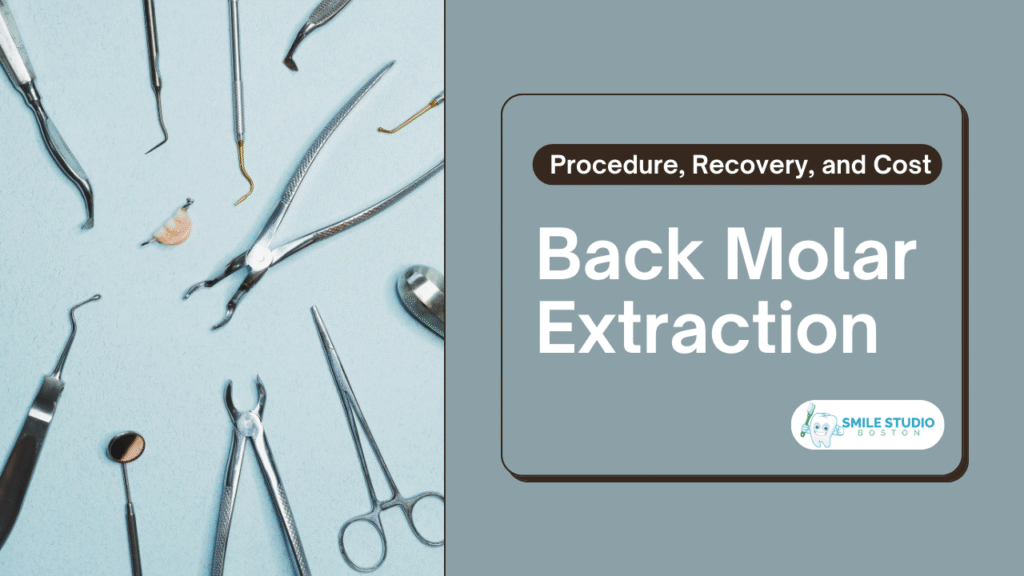“Back molar extraction is a common dental procedure performed when a molar is too damaged or infected to be saved.”
Removing a back molar can relieve pain and prevent further oral health complications, whether due to severe decay, gum disease, or an impacted wisdom tooth.
If you’re considering back molar extraction, it’s essential to understand the procedure, recovery process, and cost involved.
I. What Is an Extraction?
“A dental extraction removes a tooth from its socket in the jawbone.”
When it comes to back molars, the procedure can be more complex due to their size, deep roots, and location at the back of the mouth.
There are two types of tooth extractions:
1. Simple Extraction: This is performed on a molar that is fully erupted and can be removed easily with dental forceps.
2. Surgical Extraction: Required for impacted or broken molars; involves making an incision in the gum and may include bone removal or tooth sectioning.
Back molar extractions are often more challenging than front tooth extractions because the molars have stronger roots and are surrounded by dense bone.
II. Reasons for Back Molar Extraction
A dentist may recommend back molar extraction for several reasons, including the following:
- When a molar is too damaged for a filling or root canal, extraction is the only option to prevent the infection from spreading.
- If a wisdom tooth is trapped under the gum or grows at an incorrect angle, it can cause pain, swelling, and misalignment of other teeth.
- Advanced gum disease weakens the bone support around the molar, making it loose and requiring extraction.
- If a molar is broken below the gum line, it may be impossible to restore, making extraction necessary.
III. Procedure for Back Molar Removal
1. Before the Extraction
Your dentist will take X-rays to assess the molar’s condition and determine the best removal method. Depending on the complexity, you may receive local anesthesia, sedation, or general anesthesia for pain management.
2. During the Extraction
In Simple extraction, the dentist loosens the molar with an elevator tool and removes it with forceps.
In Surgical extraction, a small incision is made in the gum, and in some cases, the molar is cut into sections for easier removal.
3. After the Extraction
Gauze is placed to control bleeding, and your dentist will provide aftercare instructions to ensure smooth healing.
IV. Recovery After Bottom Back Molar Extraction
1. Healing Timeline
- First 24 hours: Bleeding stops, and a blood clot forms to protect the socket.
- 1 to 3 days: Swelling and discomfort peak; follow pain management instructions.
- 1 to 2 weeks: The gum tissue begins healing, but full recovery may take a month.
2. Pain Management and Diet Recommendations
- Use ice packs to reduce swelling in the first 24 hours.
- Take prescribed or over-the-counter pain relievers as directed.
- Stick to soft foods like mashed potatoes, yogurt, and soup.
- Avoid hot drinks, spicy foods, and using straws, as they can dislodge the blood clot and cause dry socket.
3. Oral Hygiene Tips
- Do not rinse your mouth vigorously for the first 24 hours.
- After a day, rinse gently with warm salt water to prevent infection.
- Brush carefully, avoiding the extraction site.
V. Complications of Back Molar Extraction
While back molar extraction is a routine procedure, potential risks include:
- Pain and Swelling: Normal after an extraction but should improve within days.
- Dry Socket: This occurs if the blood clot dislodges, exposing the bone and causing severe pain.
- Infection: Signs include severe pain, fever, and pus formation at the extraction site.
- Nerve Damage: Rare, but can cause temporary numbness in the tongue or lips.
If you experience unusual pain, excessive bleeding, or swelling, contact your dentist immediately.
VI. What to Expect After a Back Molar Is Pulled
After a back molar is extracted, you may experience:
- Changes in chewing ability: The missing tooth may affect your bite.
- Shifting teeth: Neighboring teeth might shift over time.
- Bone loss: Jawbone deterioration can occur without a replacement.
Tooth Replacement Options
- Dental Implants: A permanent solution that looks and functions like a real tooth.
- Bridges: Fills the gap using neighboring teeth for support.
- Partial Dentures: Removable and cost-effective but not as stable as implants.
Replacing a missing molar is crucial to maintaining oral health and preventing future dental issues.
Transform Your Smile with SmileStudio!
Back molar extraction is a common yet significant procedure that can relieve pain and prevent further dental complications. Whether you need a wisdom tooth removal or a damaged molar extracted, understanding the procedure, recovery, and cost will help you make an informed decision.
At SmileStudio, we believe everyone deserves a confident smile. From routine checkups to advanced cosmetic and emergency dental care, our expert team is here to help.
Why Choose SmileStudio?
✔ Top-Rated Dentists: Specialists in crowns, implants, veneers, and more.
✔ Flexible Payment Plans: Affordable options to fit your budget.
✔ Emergency Dental Care: Immediate attention when you need it most.
✔ Walk-In Appointments: Convenient care without the wait.
✔ MassHealth Accepted: Quality care, regardless of your insurance plan.
Book Your Appointment Today!
📞 Call: +1 (617) 265-5606
📧 Email: smilestudioboston@gmail.com
🌐 Visit: smilestudioboston.com
📍 Location: 1428 Dorchester Ave, Dorchester, MA 02122
SmileStudio: Where Beautiful Smiles Begin!

FAQs
1. How long does it take to extract a back molar?
A simple extraction takes about 20-40 minutes, while a surgical extraction may take 45 minutes to an hour.
2. What precautions should be taken after molar extraction?
Follow your dentist’s aftercare instructions, avoid disturbing the clot, and maintain oral hygiene with gentle rinsing.
3. How do you prepare for a molar extraction?
Eat a light meal, avoid blood thinners (if advised), and arrange for a ride home if sedation is used.
4. Can I brush my teeth after tooth extraction?
Yes, but avoid the extraction site for the first 24 hours, then brush gently around it.
5. What are the dos and don’ts after tooth extraction?
Don’t smoke, use straws, spit, rinse forcefully, or eat hard foods for at least a week.


